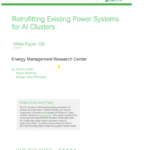Table of Contents
- Introduction
- The Changing Landscape of Enterprise Security
- What Is AI-Powered Identity Management?
- Why AI is Redefining Enterprise Security
- The Role of Machine Learning in Identity Governance
- Real-World Applications of AI-Powered Identity Management
- Challenges and Considerations
- Building an AI-Ready Identity Ecosystem
- The Future of AI in Enterprise Identity Security
- Conclusion
Introduction
In today’s hyperconnected business ecosystem, identity has become the new perimeter. With users, devices, and applications dispersed across hybrid environments, enterprises are facing mounting challenges in securing digital identities. Traditional identity management systems—built for static infrastructures—struggle to keep pace with today’s dynamic threat landscape.
Enter AI-powered identity management, a transformative approach that merges automation, intelligence, and adaptive controls to safeguard modern enterprises. For forward-thinking organizations, especially in technology and IT services, AI-driven identity management is redefining enterprise security by enhancing precision, scalability, and resilience.
At SpireITES, we explore how this evolution is not just improving security postures but reshaping how organizations think about identity governance in 2025 and beyond.
The Changing Landscape of Enterprise Security
The rapid acceleration of digital transformation has expanded the enterprise attack surface. With cloud adoption, remote work, and third-party integrations, identity has become a central element in every security framework. According to recent industry reports, nearly 80% of cyberattacks involve compromised credentials—a number that underscores the urgency of intelligent identity protection.
Legacy identity management systems were designed to handle predictable environments—where employees logged in from fixed locations using a handful of corporate applications. Today, users access multiple SaaS platforms, often from personal devices and across varied networks.
This complexity requires a dynamic, context-aware system—one capable of learning from patterns and adapting to threats in real time. That’s precisely where AI and machine learning step in.
What Is AI-Powered Identity Management?
AI-powered identity management combines traditional access control systems with artificial intelligence and machine learning (ML) models to deliver adaptive, predictive, and autonomous security responses.
Instead of relying solely on rule-based authentication, these systems continuously analyze behavioral data—such as login patterns, device fingerprints, and geolocation—to assess risk dynamically.
For example, if a user logs in from an unusual location or attempts to access sensitive data at odd hours, the AI system can automatically trigger multi-factor authentication (MFA) or temporarily restrict access until the anomaly is verified.
Key Features of AI-Driven Identity Management:
- Behavioral Biometrics: AI learns from user behavior to detect deviations that indicate potential compromise.
- Continuous Authentication: Identity is verified throughout a session, not just at login.
- Automated Threat Detection: AI identifies risks faster than manual oversight.
- Contextual Access Decisions: Permissions are adjusted in real time based on risk assessment.
- Identity Lifecycle Automation: User provisioning, de-provisioning, and access reviews are streamlined through predictive analytics.
Why AI is Redefining Enterprise Security
1. Predictive Threat Intelligence
AI’s ability to process large datasets allows it to identify potential risks before they materialize. By detecting subtle anomalies in user behavior or access requests, enterprises can prevent breaches that would otherwise go unnoticed in traditional systems.
2. Reduced Human Error
Manual identity management processes are prone to errors—misconfigured access rights, delayed revocations, or oversight during onboarding. Automation minimizes these risks by applying consistent, data-driven policies.
3. Enhanced User Experience
Security has often been viewed as a trade-off against user convenience. AI changes that narrative by delivering frictionless authentication experiences. For example, users with verified behavioral patterns may bypass unnecessary MFA prompts, improving efficiency without compromising safety.
4. Scalable Security for Hybrid Environments
As enterprises adopt hybrid and multi-cloud infrastructures, managing access across multiple platforms becomes complex. AI-powered systems integrate seamlessly across environments, ensuring consistent policies and centralized visibility.
5. Adaptive Policy Enforcement
Unlike static systems, AI continuously refines access policies based on evolving threats, usage trends, and compliance requirements. This adaptability is crucial in industries like healthcare, finance, and IT services, where regulatory landscapes are constantly shifting.
The Role of Machine Learning in Identity Governance
Machine learning lies at the heart of AI-powered identity management. Through advanced algorithms, ML models can:
- Correlate millions of access events to detect emerging risks
- Recognize normal versus abnormal activity patterns
- Recommend least-privilege access policies
- Predict insider threats based on behavioral shifts
This capability turns identity governance from a reactive process into a proactive one. Instead of discovering violations after they occur, enterprises can anticipate and neutralize threats in advance.
At SpireITES, we’ve observed that organizations adopting ML-based identity systems report significantly fewer security incidents and improved audit readiness, particularly in regulated industries.

Real-World Applications of AI-Powered Identity Management
1. Continuous Risk Scoring
AI continuously calculates a risk score for every user based on contextual factors like device health, IP reputation, and behavioral consistency. Access rights can then be dynamically adjusted based on these scores.
2. Zero Trust Enablement
AI simplifies the implementation of Zero Trust architecture by continuously verifying identities and enforcing least-privilege access principles. Trust is never assumed; it’s algorithmically validated.
3. Insider Threat Detection
By analyzing deviations from established behavioral baselines, AI can flag potential insider threats—employees or contractors whose actions deviate from typical usage.
4. Automated Compliance Management
AI tools streamline compliance by monitoring policy adherence, generating audit trails, and ensuring data sovereignty in line with frameworks like ISO 27001 or GDPR.
5. Intelligent Incident Response
In case of a suspected breach, AI systems can isolate compromised accounts, trigger alerts, and even initiate remediation workflows—reducing the time to containment.
Challenges and Considerations
While the benefits of AI-powered identity management are immense, successful adoption requires addressing several key challenges:
- Data Privacy: The collection and analysis of behavioral data must comply with global privacy laws.
- Algorithmic Bias: Poorly trained AI models can produce false positives or negatives, leading to trust issues.
- Integration Complexity: Aligning AI-driven tools with legacy systems may demand architectural modernization.
- Skill Gaps: Security teams must acquire AI literacy to manage and interpret algorithmic outputs effectively.
Mitigating these risks requires strategic planning, ethical frameworks, and vendor collaboration.
Building an AI-Ready Identity Ecosystem
To fully realize the potential of AI in identity management, enterprises should focus on foundational readiness:
- Data Quality: AI models depend on accurate, clean, and diverse datasets.
- Interoperability: Systems should be API-first and capable of integrating across diverse platforms.
- Human-AI Collaboration: AI should augment, not replace, human decision-making.
- Continuous Learning: As threats evolve, AI models must be regularly retrained with fresh data.
- Governance and Accountability: Clearly defined ownership ensures responsible deployment and compliance alignment.
Organizations that invest early in these foundations position themselves to lead the next wave of intelligent security transformation.
The Future of AI in Enterprise Identity Security
By 2025 and beyond, AI-driven identity management will evolve from innovation to necessity. We can expect:
- Identity as a Service (IDaaS) becoming fully autonomous through AI orchestration
- AI-augmented Zero Trust models offering continuous authentication at every layer
- Self-healing identity ecosystems that detect, respond, and adapt autonomously
- Integration with quantum-resistant cryptography for long-term data integrity
In essence, the future belongs to organizations that treat identity not just as a security control but as a strategic enabler of digital trust.
Conclusion
The convergence of AI and identity management marks a defining moment in enterprise security. As cyber threats grow more complex and boundaries between networks blur, only intelligent, adaptive systems can ensure resilience.
At SpireITES, we believe that AI-powered identity management represents more than technological progress—it’s a paradigm shift toward predictive, self-learning security ecosystems. By investing in these innovations today, enterprises can safeguard their digital future, strengthen trust, and unlock new possibilities for growth.
The question is no longer if AI will reshape identity security, but how quickly your organization will adapt.








Leave a Reply